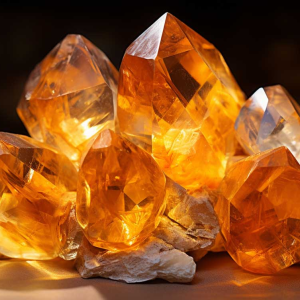Natural crystals for the jewellery industry
Natural crystals are widely used in the jewelry industry due to their beauty, durability, and symbolic significance. Below are the most commonly used natural crystals for jewelry:
1. Quartz Varieties
Quartz is one of the most versatile crystals used in jewelry, available in a wide range of colors and forms:
- Amethyst: Purple quartz valued for its vibrant hue and spiritual properties.
- Citrine: Yellow to orange quartz associated with warmth and energy.
- Rose Quartz: Soft pink quartz symbolizing love and harmony.
- Clear Quartz: Colorless quartz often used for minimalist designs and metaphysical purposes.
- Smoky Quartz: Brown to gray quartz with a grounding and earthy appeal.
2. Diamond
- Composition: Pure carbon (C).
- Properties: Exceptional hardness (Mohs 10), brilliant luster, and remarkable light dispersion.
- Uses: The most prized gemstone in engagement rings and high-end jewelry.
3. Sapphire
- Composition: Corundum (Al₂O₃).
- Properties: Second-hardest mineral (Mohs 9), typically blue but found in other colors like pink, yellow, and green.
- Uses: Used in rings, necklaces, and earrings for its vibrant colors and durability.
4. Ruby
- Composition: Corundum (Al₂O₃) with chromium impurities.
- Properties: Red color, high hardness (Mohs 9), and exceptional brilliance.
- Uses: A symbol of passion, rubies are often used in luxury and vintage jewelry.
5. Emerald
- Composition: Beryl (Be₃Al₂Si₆O₁₈) with chromium and vanadium.
- Properties: Rich green color, moderate hardness (Mohs 7.5–8), and unique inclusions known as “jardin.”
- Uses: Popular in fine jewelry and antique designs.
6. Topaz
- Composition: Al₂SiO₄(F,OH)₂.
- Properties: Comes in a variety of colors, including blue, yellow, pink, and clear; hardness of 8 on the Mohs scale.
- Uses: Common in rings, pendants, and bracelets.
7. Aquamarine
- Composition: Beryl (Be₃Al₂Si₆O₁₈).
- Properties: Pale blue to greenish-blue; moderate hardness (Mohs 7.5–8).
- Uses: Valued for its calming color, aquamarine is used in elegant, understated jewelry.
8. Tourmaline
- Composition: Complex borosilicate with various elements.
- Properties: Found in many colors, including pink, green, blue, and multicolored varieties; hardness of 7–7.5.
- Uses: Its unique shades make it a favorite for custom jewelry.
9. Garnet
- Composition: Group of silicate minerals with varying compositions.
- Properties: Usually deep red but available in green (tsavorite) and orange (spessartite); hardness of 6.5–7.5.
- Uses: Common in vintage and artisanal jewelry.
10. Peridot
- Composition: Olivine ((Mg,Fe)₂SiO₄).
- Properties: Lime green color; moderate hardness (Mohs 6.5–7).
- Uses: Popular in boho and modern jewelry designs.
11. Spinel
- Composition: MgAl₂O₄.
- Properties: Found in various colors, including red, pink, blue, and lavender; hardness of 7.5–8.
- Uses: Often mistaken for rubies, spinels are gaining popularity in fine jewelry.
12. Tanzanite
- Composition: Zoisite (Ca₂Al₃(SiO₄)₃(OH)).
- Properties: Unique blue-violet color; moderate hardness (Mohs 6–7).
- Uses: A rare and exotic gemstone used in high-end jewelry.
13. Opal
- Composition: Hydrated silica (SiO₂·nH₂O).
- Properties: Play-of-color effect, moderate hardness (Mohs 5.5–6.5).
- Uses: Used in statement pieces for its unique and iridescent appearance.
14. Moonstone
- Composition: Feldspar group.
- Properties: Adularescence (soft, glowing light effect), hardness of 6–6.5.
- Uses: Favored in bohemian and spiritual jewelry designs.
15. Alexandrite
- Composition: Chrysoberyl (BeAl₂O₄).
- Properties: Rare gemstone known for its color change from green to red under different lighting; hardness of 8.5.
- Uses: Highly sought after for its rarity and unique optical properties.
These natural crystals offer a combination of beauty, symbolism, and durability, making them ideal for various styles and occasions in the jewelry industry.


Leave a Reply
Want to join the discussion?Feel free to contribute!